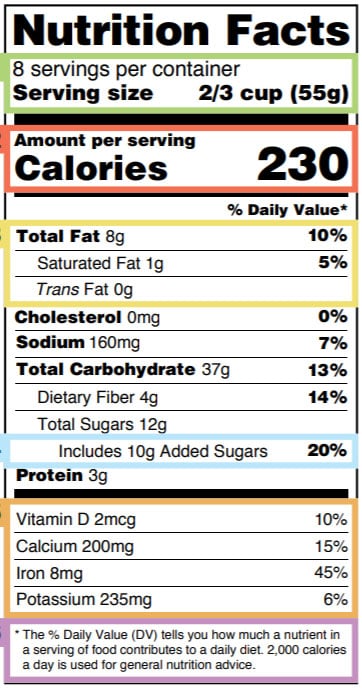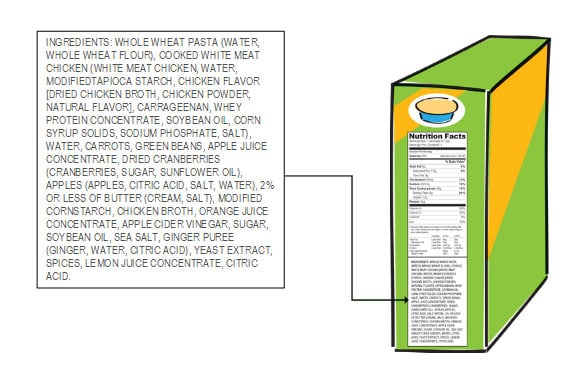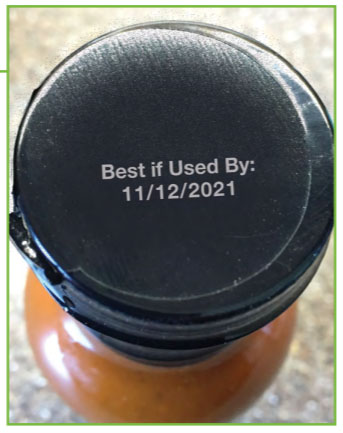How to Read Food Labels
The nutrition facts label is a helpful tool for making healthy choices. Whether you are watching your sodium or sugar intake, this guide will help you make sense of the numbers, ingredients and nutritional information on every food package.
Nutrition Facts Label: How to Make Healthy Choices
The Nutrition Facts Label is commonly found on the back or the side of food packaging. It’s a tool to help you make healthy food choices. To better understand how to use this label, learn more about its different parts:

Serving Size
The Serving Size is based on the amount that people typically eat and drink. It is not a recommendation of how much to eat or drink. All Nutrition Facts Label information is based on this measure. The Serving Size may be in grams (g), cups, package, tablespoons (tbsp), or slices.
Servings Per Container
The Servings Per Container are the total number of servings in a box of food.
Calories
The Calories section is in large, bold font that tells the total number of calories or energy in a single serving. If you double the serving size, then you would double the calories you eat.
Percent Daily Value (%DV)
Percent Daily Value (%DV) shows the amount of a nutrient that is in one serving. It is a percentage on the right side of the Nutrition Label.
Each value is based off of a 2,000-calorie daily diet. This is the number of calories that most Americans should aim to eat every day. But this is just a guideline, and the number of calories you need is based on your age, height, weight, physical activity, and your health goals.
Nutrients
All Nutrition Facts Labels must list: total fat, saturated fat, trans fat, cholesterol, sodium, total carbohydrate, dietary fiber, sugars, added sugars, protein, vitamin D, potassium, calcium, and iron.
Get more of: Vitamins, Minerals, Protein, Fiber, and monounsaturated & polyunsaturated fat. Examples of unsaturated fats include: nuts, seeds, fatty fish, olive oil, and canola oil.
Be sure to limit: Sugar, Sodium, and saturated fats & trans-fats also known as “solid fats.” Limit butter, shortening and fats from meats.
Use the Nutrition Facts Label to compare the nutrient content of food items. If your health goal is to eat less sodium, or salt, compare the sodium content of two items to determine the lowest option.

Ingredients Label: Knowing What’s in Your Food
An Ingredient Label is found below the Nutrition Facts Label. This label lists what is in the packaged food. The ingredients are listed by weight in descending order. So, if the ingredient is listed first, then there is the most of that ingredient in the food.
Product Dates: What You Need to Know
“Best if used by”, “Sell by”, and “Use by” dates are found on most packaged foods. These dates do not tell when a food expires or goes bad, but instead tell when the food is at its best quality. Foods are typically safe to eat after the listed date.
Food and Beverage Product Dates Explained:

- “Best if used by”: Indicates when a product will be at its best quality.
- “Sell by”: Tells the grocery store how long to display the product for sale. The product will still be safe to eat past this date and still has a third of its shelf-life left.
- “Use by”: Last date for use of product at its best quality. The food quality may decrease quickly after this date. Infant formula is the only product that should be thrown out past the “Use by” date.
Bottom Line: If you see a food that is past its “Best by”, “Use by”, or “Sell by” date, look for signs of it going bad like an unfamiliar smell, curdling, or color change.